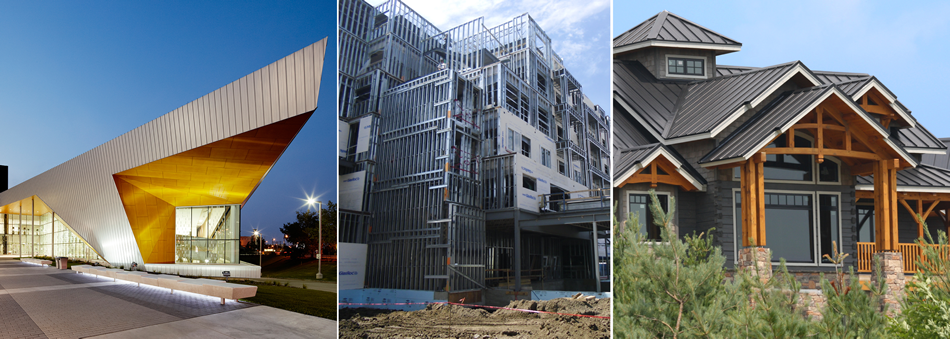Introduction
Les toitures et les parements (revêtements) en tôle d’acier sont offerts dans une grande variété de profils, de couleurs et de systèmes de peinture. Les systèmes prépeints modernes utilisés sur des produits canadiens fourniront des décennies de bon rendement avant de montrer des signes visibles de détérioration de la surface peinte. Cependant, un composant important du système de parement, c’est l’attache utilisée pour le fixer sur la structure. Cette attache n’est pas seulement une vis; elle fait partie de l’assemblage du toit ou du mur et on doit s’attendre à ce qu’elle fournisse le même rendement à long terme. Ce rendement n’est pas simplement la capacité de garder le parement de façon sécuritaire en place, mais il doit également correspondre à la couleur et la durabilité de la peinture.
La sélection de la vis appropriée au travail est la première étape de la création d’un système de parement qui fournira un rendement à long terme. L’étape suivante, c’est l’installation. L’installation de vis dans un parement en tôle d’acier est chose courante et peut être fait très de manière efficiente. Les fabricants d’outils ont développé une vaste gamme d’options pour les attaches d’installation dans n’importe quel type d’infrastructure. Le choix de l’outil le plus approprié aidera lors du processus d’installation. Malheureusement, il est possible d’endommager la peinture sur la vis lors de l’installation, comme montré dans la photo ci-dessous.
Effet du type d’outil d’installation sur une tête de vis
Un projet de recherche a été mené pour l’ICTAB pour étudier le rendement d’outils d’utilité courante utilisés pour installer des vis qui retiennent un parement sur une ossature en bois. L’objectif était d’évaluer l’outil privilégié pour tenir la tête de la vis peinte durant l’installation. L’étude ne portait pas sur l’évaluation de différents finis (p. ex., peinture en poudre, peinture fraîche ou peinture organique) ni sur l’évaluation de différentes marques d’outils. L’étude a porté seulement sur l’effet que les différents mécanismes d’outil (p. ex., rotation, percussion, chocs ou combinaison) avaient sur la vis durant le processus d’installation.
Cinq types d’outils ont été testés :
- Tournevis électrique avec mandrin à profondeur réglable
- Perceuse à percussion à batterie
- Tournevis à batterie avec commande du couple réglable
- Tournevis/perceuse électrique
- Tournevis à chocs à batterie
Les tests suivants ont été effectués :
- Maîtrise (vitesse) d’installation des outils
- Choc (dommage) à cause des outils sur la protection contre la rouille - Accéléré
- Choc (dommage) à cause des outils sur la protection contre la rouille - Normal
- Protection contre la rouille des vis jamais installée
Le problème en réalité consiste à trouver le bon équilibre entre le dommage potentiel causé à la tête de la vis peinte et la vitesse d’installation. L’évaluation des données du test était fondé sur une pondération 70/30 de la réduction des dommages et du temps d’installation respectivement. À l’aide de ce critère de sélection, les premiers choix ont été le tournevis électrique avec mandrin à profondeur réglable et le tournevis/la perceuse électrique. Les pires choix ont été la perceuse à choc et le tournevis à choc.
Quels que soient les critères d’évaluation, le tournevis à chocs était toujours nettement le pire. Les forces de choc agissant sur la tête de la vis endommageront la surface de la vis et causeront une corrosion précoce. Même si les tests ont été réalisés sur des têtes de vis peintes, les mêmes conclusions s’appliquent également aux vis à tête non peinte et en nylon.
Outils recommandés et méthodes d’installation
Tournevis
Les attaches pour toiture et parement en tôle d’acier prépeinte doivent avoir une tête de forme hexagonale. L’outil d’installation comprend un tournevis adapté au format et à la forme de la tête de vis. Souvent, ce tournevis comprend un aimant encastré pour retenir la vis en place durant l’installation. Le fait de passer la vis au travers de la tôle d’acier rejettera les limailles d’acier qui peuvent s’accumuler sur l’aimant du tournevis. Ces limailles doivent être enlevées régulièrement afin que la tête de la vis s’emboîte fermement dans la douille du tournevis. Les tournevis s’usent rapidement et doivent être remplacés après avoir vissé 5000 vis.
Vitesse de pistolet à vis
Que vous utilisiez une vis autoperceuse ou une vis autotaraudeuse, la vitesse (tr/min) du pistolet à vis est importante. Des vitesses plus basses de pistolet à vis amélioreront le rendement du perçage en réduisant la chaleur générée durant le processus de perçage. Pour fixer du parement en tôle d’acier dans des conditions de métal sur métal ou de métal sur bois avec des vis en acier au carbone, la vitesse maximale recommandée est de 2500 tr/min, Des vitesses plus basses peuvent être souhaitables pour percer dans des éléments plus épais ou avec des vis en acier inoxydable. Le fabricant des vis devrait être consulté.
Serrage des attaches
Les attaches exposées pour les systèmes de parement en tôle d’acier comprennent une rondelle sous la tête de la vis pour former un joint étanche. Il est très important que les attaches soient serrées adéquatement afin d’obtenir une étanchéité optimale. Assurez-vous que la rondelle soit comprimée, mais pas jusqu’au point où elle ressortira des côtés de la tête de la vis. Le fabricant des vis devrait être consulté.
Conclusion
Les installateurs de parement en tôle d’acier doivent examiner leur choix de pistolet à vis et l’effet qu’il peut avoir sur le rendement à long terme du revêtement de la tête de la vis. L’objectif, c’est de créer un assemblage de toiture et de mur durable, et ceci comprend les attaches. Contribuez à maintenir la qualité des attaches en utilisant un tournevis/une perceuse et non pas un outil qui met la vis en place par des chocs. Soyez également conscient de la vitesse d’installation et de la compression appropriée de la rondelle.

























